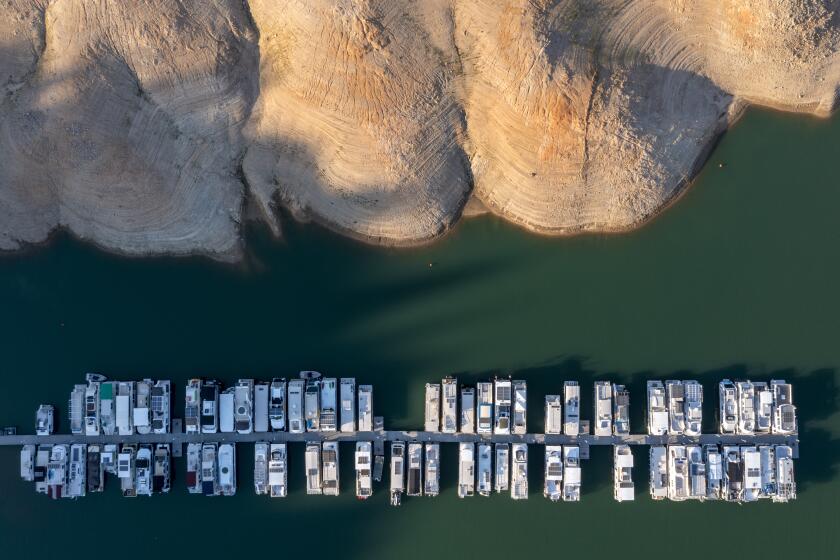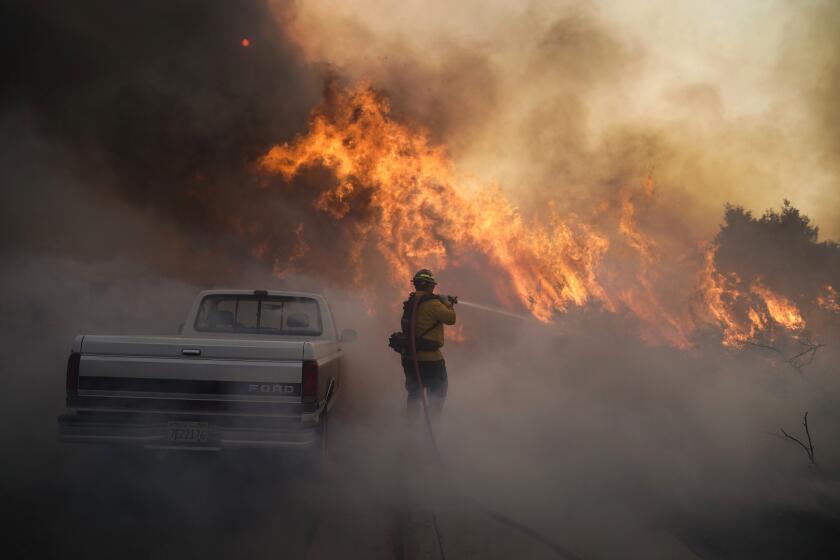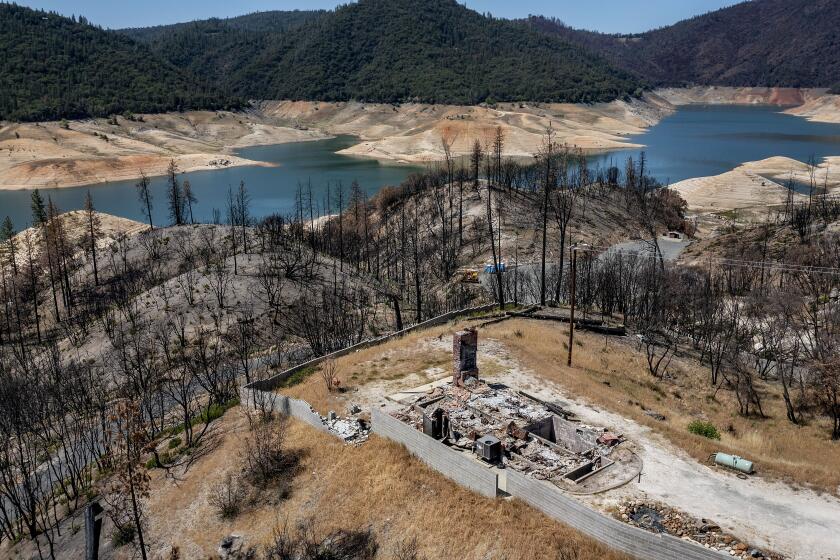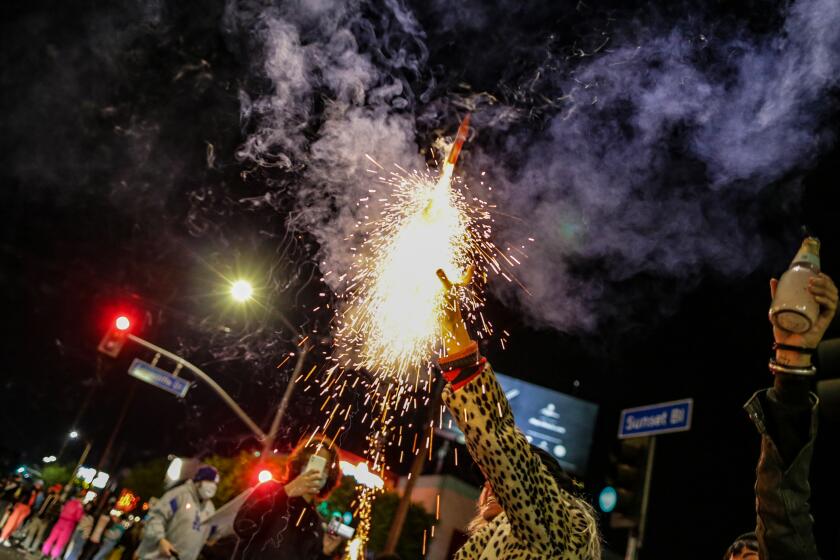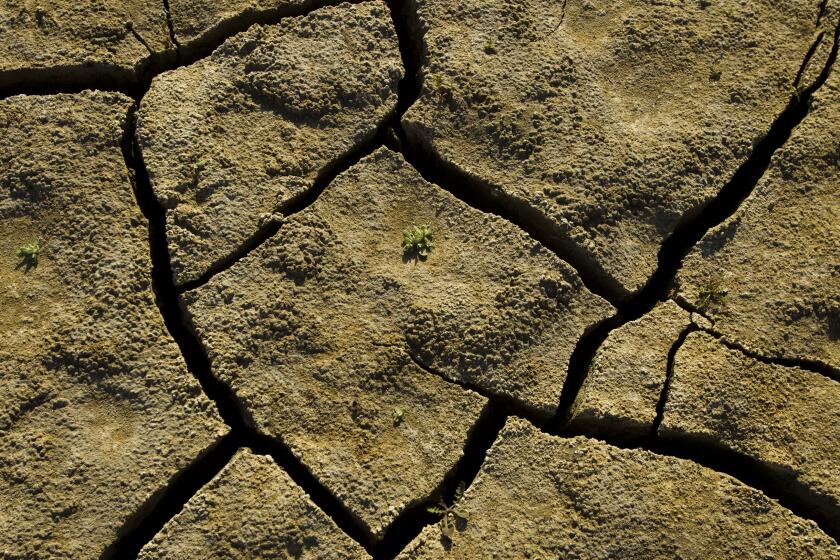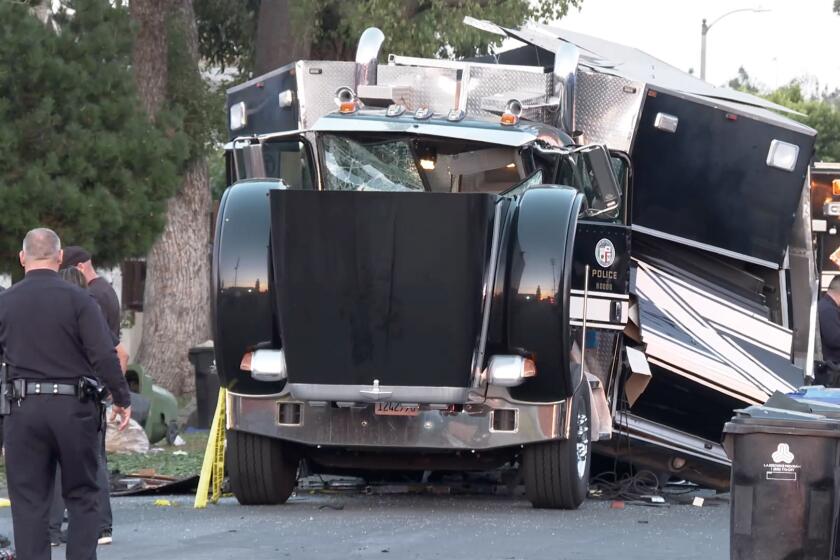No such thing as ‘safe and sane’ fireworks in a bone-dry California primed to burn
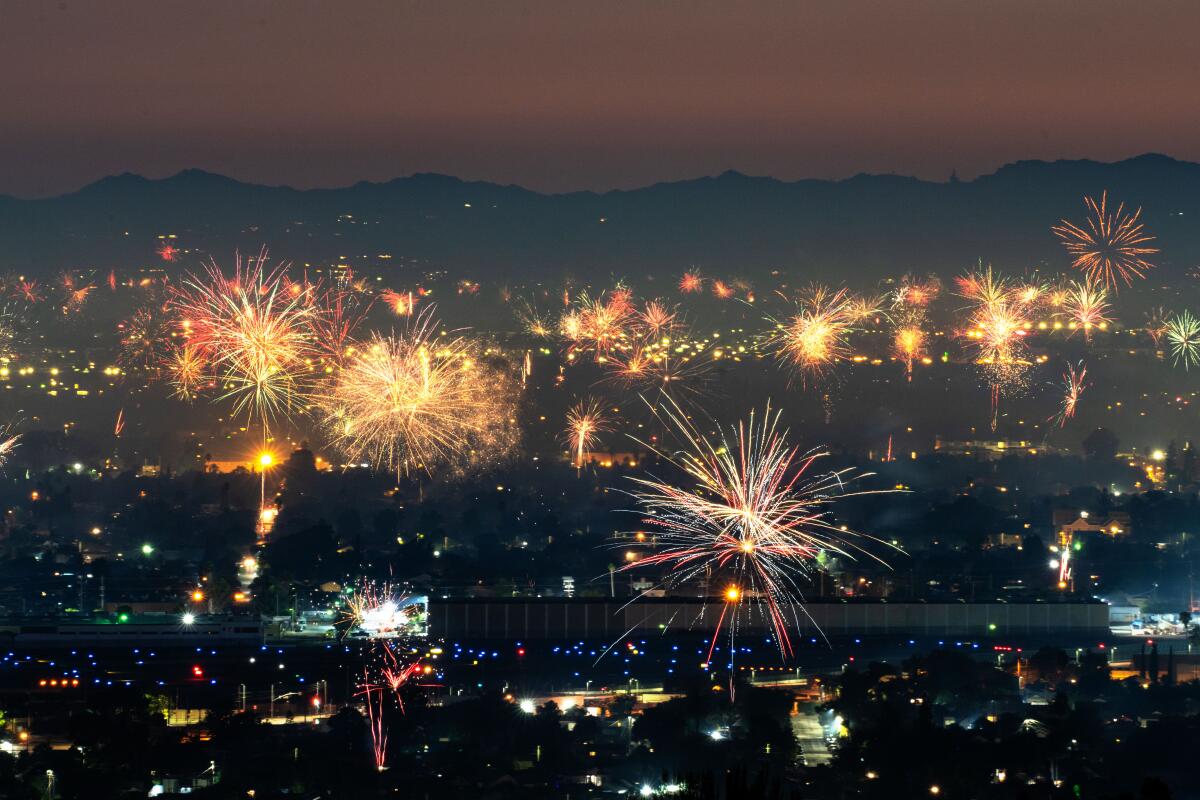
- Share via
On a Monday evening in June, Rosimeiry Brown was making a smoothie when she felt a draft of hot air envelop the kitchen and looked out the window of her Vallejo home.
“I could feel heat, and I looked over my shoulder and I could see fire,” said Brown, 42, describing a blaze that was climbing up her neighborhood’s brushy hillside. “Like a wall of fire.”
Minutes earlier, residents had reported hearing sharp, popping sounds — a common occurrence in the area — and investigators now believe the wildfire that scorched at least 10 acres and sent a firefighter to the hospital was probably caused by illegal fireworks.
It’s a scenario that public safety officials fear could be a preview of a fiery Fourth of July as fireworks explode across drought-stricken California.
While droughts are common in California, this year’s is much hotter and drier than others, evaporating water more quickly from the reservoirs
The troubling trend lines, decades in the making, have only accelerated. 2020 marked the worst wildfire season California had ever seen, and last month was one of the hottest, driest Junes in recent memory. Yet even as the state grows increasingly combustible, fireworks are proliferating like never before, creating what experts call a recipe for potential disaster.
“The conditions are dry and ready to burn,” Chief Mike Richwine of the California Department of Forestry and Fire Protection said during a news conference Thursday, “and all it takes is a single firework or a single spark.”
The drought has dried up millions of acres of forestland and chaparral-studded mountains across rural California, but it has also left vulnerable countless areas in big cities and suburbs that abut parched hillsides and canyons. In many of these neighborhoods, the bangs, booms and pops of fireworks erupt on a regular basis, and often intensify in the days surrounding the Fourth of July holiday.
Officials and wildfire experts are now pleading with the public to refrain from setting off fireworks, and authorities in L.A. are moving to ban online sales and make it easier to issue violations.
But despite the increased danger, fireworks persist as one of L.A.’s favorite illicit pastimes, and the explosives continue flooding into the state: Cal Fire, in conjunction with federal, state and local agencies, seized nearly 80,000 pounds of illegal fireworks along the California border in May and June alone, said Richwine, who is also the state fire marshal.
“Ten years ago, 15 years ago, it was just a few people in an area that would have access” to fireworks, he said. “Now it’s in every community, almost on every street.”
Facing his first wildfire season as president, Biden will discuss federal preparedness Wednesday with his Cabinet and Western governors, including Gavin Newsom.
In California, there are two categories of fireworks — “dangerous” and “safe and sane.”
Dangerous fireworks include rockets, firecrackers, Roman candles and those made with a variety of chemicals such as boron and arsenic sulfide. Safe and sane fireworks include fountains, sparklers, snap caps and other small items that don’t leave the ground.
While some parts of Los Angeles County allow safe and sane fireworks, all fireworks are illegal in the city of Los Angeles and in unincorporated areas, officials said.
Exceptions are made for public fireworks shows conducted by state-licensed pyrotechnicians.
Otherwise, “if it’s airborne, it’s illegal,” said Daryl Osby, fire chief of the Los Angeles County Fire Department.
Although the “wow” factor differs dramatically between backyard fireworks and professional fireworks, their mechanisms are nearly identical, said Julie Heckman, executive director of the American Pyrotechnics Assn.
“In terms of the science and the chemistry, and how they’re made, basically they are one and the same,” she said.
Professional fireworks typically burst between 500 and 800 feet in the air, Heckman said, depending on the size of their shells. Consumer fireworks burst at closer to 200 feet.
The blast radius and spread of debris depends on the shell’s effects, she said, but sparks can travel, especially if there is wind.
“Our posture is, you need to obey your local law, and if there are drought conditions and burn bans, you should abide by those,” she said, noting that even simple sparklers burn at roughly 1,800 degrees Fahrenheit.
State leaders in climate change and water resources warn that California’s drought is already causing dire conditions for people, plants, animals and land.
Yet Heckman and others acknowledged that just because something is illegal doesn’t mean people won’t do it. In fact, many agencies reported a significant increase in firework explosions during the COVID-19 pandemic, officials said.
“It’s out of control,” Osby said. “Every year, we confiscate more illegal fireworks. We think that’s a good year, but if you live in Los Angeles County, you can see all the aerial fireworks that go up. They’re all illegal.”
The problem has become so widespread that Los Angeles City Atty. Mark Feuer last week vowed to disrupt the supply chain by cracking down on online sales.
Days later, the Los Angeles City Council unanimously approved a motion directing the city’s fire and police departments to look into a system that would track and respond to fireworks complaints through a mobile application that would issue automatic violations.
A similar program has been established in San Bernardino County.
“The bottom line has to be safety,” Councilmember Mark Ridley-Thomas said in a statement about the motion, which he wrote. “Too many of our neighbors are literally playing with fire, and the results can be lethal.”
Mike Feuer said he was focusing on shutting off the supply chain.
Last month, more than 100 fire scientists signed a letter urging the Western U.S. to forgo fireworks this Fourth of July. The letter noted that this year’s holiday will be “like no other we’ve experienced in the nation’s history” because of the heat and drought.
Jacob Bendix, a professor at Syracuse University who specializes in the study of wildfire distribution, was one of the scientists who signed the letter. He said there is “no question” that the current conditions make the fire danger greater. The West has in recent weeks been mired in treacherous, record-breaking heat.
And while dryness is a huge factor, the heat adds to the threat because it draws moisture from plants and evaporates water from the soil, making vegetation drier, he said. It also preheats fuels so that they ignite more readily and enable fire to spread faster.
Given the increasingly flammable landscape, “pleas to skip the fireworks make perfect sense,” Bendix said.
“This is particularly true in Southern California, where the vast majority of wildfires are started by people rather than lightning,” he said, “so that it is largely in our hands as to whether our behavior causes catastrophe.”
In Los Angeles, fines for selling or discharging fireworks in the city and the county can range as high as $1,000, officials said. But, as many Angelenos can attest, those penalties don’t seem to deter some residents from igniting the explosives at all hours of the day and night.
“Every year it gets worse,” said City Terrace resident Mary Lou Hernandez, who has lived in the East Los Angeles neighborhood since 1962. “I think the individuals who are doing this are not mindful, and they don’t care about their surroundings. They don’t have any regard for anyone anymore.”
California has entered another drought. But depending on who you ask, the last one may have never really ended.
In 2019, the Los Angeles County Fire Department responded to three fires that started because of fireworks, Osby said. In 2020, that number exploded to 39.
And vegetation dryness heading into the Fourth of July weekend this year is at levels not typically seen in the area until the end of August, according to Osby.
“I’m really concerned,” he said. “Our hillsides are dry. They are crispy.”
On the Fourth of July last year, the Los Angeles Fire Department responded to 424 more emergency incidents than the daily average, according to spokesperson Erik Scott. Calls included fires in rubbish, trees, grass and structures near the dangerous displays.
Some chalked up last year’s increase in firework activity to early pandemic boredom, but on Wednesday, 17 people were injured when a bomb squad attempted to detonate explosive devices that had been seized from a South Los Angeles home along with about 5,000 pounds of illegal fireworks.
The threat of even more catastrophe looms this weekend, said Robert Garcia, fire chief of the Angeles National Forest.
Adding to his concerns are what Garcia described as a “long history” of fireworks-related challenges. Between sundown and sunrise on the Fourth of July holiday last year, for example, the Angeles National Forest team responded to more than 20 wildfires.
It is bracing for a similar pattern this weekend and is bringing in additional resources, including more crews and engines to help with the response, he said.
“We’re pleading with the public to help us address the 90% of wildfires that are human-caused,” Garcia said. “That’s going to be the fireworks, that’s going to be the barbecues. These incidents emerge rapidly, and they affect far more people than just those that are directly affected.”
Authorities were in the process of seizing more than 5,000 pounds of illegal fireworks at the time of the explosion in South Los Angeles.
Yet some who have come face-to-face with fireworks-sparked blazes are all too familiar with how stubborn some people can be when it comes to the explosive devices.
Brown, whose Vallejo neighborhood lit up with flames less than two weeks ago, said people in the area are already back to igniting fireworks every night.
And while Brown understands their appeal, she urgently wants people to think about their danger, she said. The wildfire came within just a few feet of her home.
“It’s very fun, and it’s beautiful to watch,” Brown said of the explosive displays. “But the thing is, nobody really knows how to control fireworks.”
More to Read
Sign up for Essential California
The most important California stories and recommendations in your inbox every morning.
You may occasionally receive promotional content from the Los Angeles Times.
